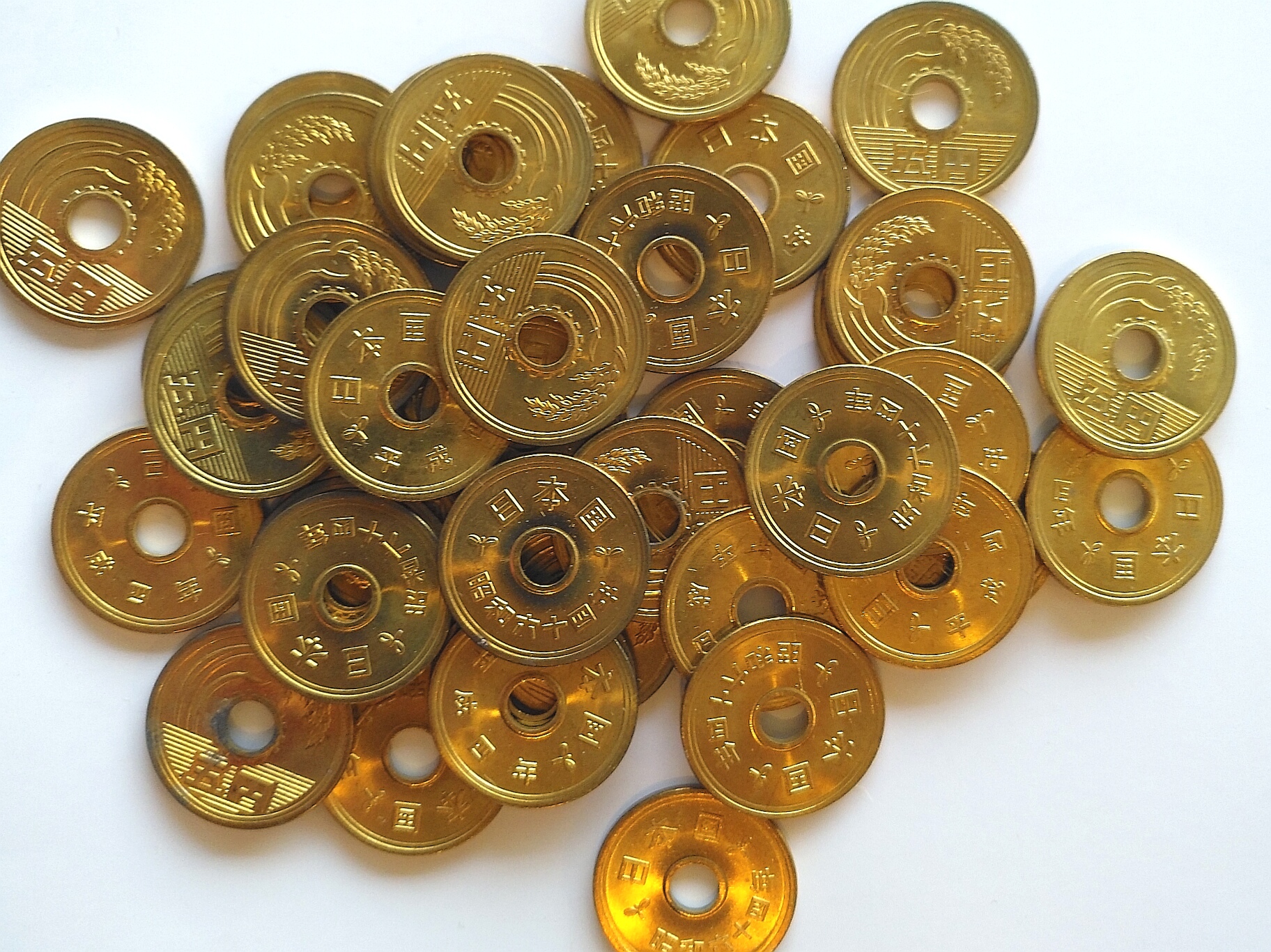Destiny And The 5-Yen Coin
Most Japanese people believe in destiny. The term "go-en" (ご縁) refers to those seemingly serendipitous encounters that result in long and meaningful relationships. It would often mean a bond between people but it could also refer to connections with objects (like a house, a painting, or even a favourite teacup!) or a calling. Ask people how their career started, how they met their partners or how they found that perfect piece of furniture. Most answers would probably boil down to a mixture of perseverance and luck. Japanese people would say "Go-en ga arimashita." (ご縁がありました。)There was "go-en" involved in the outcome. It was meant to be!
The Japanese 5-yen coin is also called “go-en” 五円. Because it sounds the same as the “go-en” of destiny, many Japanese people believe that having a 5-yen coin around helps them find what the Universe has in store for them. It could be a soul-mate, a dream job, the perfect house, etc. In shrines and temples, it is also the coin of choice when tossing a token offering into the collection box (賽銭箱 saisen-bako) whilst saying a prayer of thanks and/or a wish for something in the future (in that order). The 5-yen coin helps along the good luck and the serendipity that is actually meant to be!
Extra trivia: Using a 10-yen coin for your prayers and wishes is not advisable. Another word for "10" is "toh" (十). So, the 10-yen coin could be called "toh-en" (十円). Now, another meaning for the word "toh" (遠) is "far" ...and putting them together as "toh-en", it can be written as "遠縁", which means "far destiny"! So the 10-yen coin is something that keeps your destiny out-of-reach!
We made a few items to help keep your lucky 5-yen coin handy, always ready to to attract the good luck in! All hand-made in-house with loving care. Available at the shop while supply lasts.
An origami pouch to keep your 5-yen coin in your wallet or purse.
A crane ornament to display in your home or office.
My Ikebana: Climbing Up To Sengai
From Sogetsu Textbook 5, this arrangement is on the theme of yuka agari (床上がり) Floor Position Arrangement. The arrangement originates from the floor and is created while being conscious that it will be viewed from a standing eye-level.
The painting on the wall is a replica of "The Willow" by Sengai Gibon (1750-1837), a Zen monk.
I hope you like it. --Miyako
Ikebana Lessons Fee Change
This announcement is for our ikebana students.
Sadly, the time has come to announce an increase in our ikebana lesson fees. This is the first time that lesson fees are being raised since Miyako started teaching in 2008. Even as flower prices kept going up through the years, we were able to keep the fees unchanged with the help of the economy of scale afforded by more students coming to learn...that is up till now.
New Ikebana Lesson Fees effective from January 1, 2018.
Single Lesson 50.00 +HST
3-Lesson Set: 125.00 +HST
Lessons that have already been paid for will be honoured with no additional fee.
Thank you very much for your understanding and continued support.
My Ikebana: Welcoming Autumn
Here in Canada, autumn is a time of leaves changing colours. It is also the time of harvest and we see a lot apples, pumpkins and gourds.
To welcome autumn, I used the fruits of harvest in an ikebana arrangement. Unlike flowers, they are heavier and have dense, compact shapes. It was a bit of a challenge to incorporate them in an arrangement!
In case you are wondering, I used the thick metal hanadome to hold up the heavy fruit!
Here is the whole arrangement..
I hope you like it. --Miyako
"Sō" Magazine October 2017
Last year Miyako conducted an ikebana workshop with a group of St. Mary's University students. This activity is featured in the October, 2017 edition of "Sō" (「草」) magazine, the official publication of the Sogetsu Teachers' Association.
See more about that workshop here.
Demo At The Mahone Bay Garden Club
Thank you very much to the Mahone Bay Garden Club for your warm welcome last night!
We were very happy for the opportunity to introduce ikebana to you. We loved your insightful questions and sharp observations! We hope you enjoyed our presentation!
Maybe we'll see some of you in our ikebana lessons one day!
My Ikebana: Linden Branches, No Kenzan
Sometimes, we prefer to create an arrangement on a suiban (flat container) without using kenzans because we are able to show the beauty and purity of the water without any disruption.
The challenge for making this type of arrangement is putting together a stable frame. The key is to choose the appropriate branch and set them on 3 legs. Once the basic structure is secure, then we can add more materials and start having fun with the arrangement!
I used linden tree branches (picked up from the sidewalk!) with pink roses and solidaster. Here is the whole arrangement.
I hope you like it. --Miyako
"Sō" Magazine August 2017
The arrangement displayed during the Afterglow Art Festival 2016 in Bridgewater NS was featured in the August 2017 issue of "Sō" (「草」) Magazine, the official publication of the Sogetsu Teachers' Association.
To find out more about what we did at the Afterglow Art Festival 2016, please click here.
Introducing Sogetsu Textbook 5
The Sogetsu School of Ikebana has recently introduced a new textbook, Textbook 5: Technique & Creation, to its curriculum. Completion of Textbook 5 is now a prerequisite in order to obtain the Teacher's Diploma 4th Grade. Iemoto Akane Teshigahara and other Sogetsu masters have been conducting seminars for Sogetsu teachers to update them regarding the instruction of Textbook 5. It is important to note that only teaching members of the Sogetsu Teachers' Association (STA) who have successfully completed the Textbook 5 special training sessions are qualified to teach Textbook 5.
Unfortunately, there has been no opportunity yet for a Sogetsu master to visit Canada (let alone little ol' Halifax!) to conduct a training session. So this summer, Miyako travelled to Tokyo to attend the Iemoto's seminar at the Sogetsu headquarters! We are happy to announce that Miyako successfully completed the seminar so all of her students who have finished Textbook 4 may begin challenging Textbook 5!
So what's new with Textbook 5?
The greatest impact of the introduction of Textbook 5 is the standardization of the curriculum on the way to obtaining the Teacher's Diploma 4th Grade. In the past, after finishing Textbook 4, students needed to take more preparatory lessons before applying for the Teacher's Diploma. Those lessons fell into a kind of grey area where the content was based on the individual teacher's discretion. The old system did work in the sense that the teacher was able to re-direct the student's attention to themes that needed reinforcement. However, the system also resulted in differences in training experience, depending on what one's teacher decided to focus on. Textbook 5 replaces that "grey area" and provides a standard and solid lesson plan for Teacher's Diploma preparation.
The content of Textbook 5 is described by four key words: "technique", "materials", "placement", and "creation". Above all of that is the emphasis on self-knowledge. Only with profound self-knowledge could one uniquely express oneself through ikebana and have the confidence to become another's teacher.
There are many, many things to look forward to in Textbook 5...from new techniques in securing an arrangement in a spherical tsubo vase (if you thought nageire was difficult, think again!) to creating an arrangement from behind. Textbook 5 also shows us examples of arrangements in situ...i.e. in the the actual locations where the arrangements were meant to be placed. It gives us fresh ideas on where ikebana can be incorporated in our living space. Indeed, ikebana arrangements are meant to be placed somewhere....not just at a photographer's studio! Other samples of interesting challenges are the use of mizuhiki (paper cord) for celebratory arrangements and creating ikebana to complement an art work. We will stop here and let you explore Textbook 5 on your own!
Browse through Textbook 5 next time you are in the studio for your lessons and see what you can look forward to! It is available to students who have completed Textbook 4. (Please note: We do not sell Sogetsu textbooks to the general public.)





